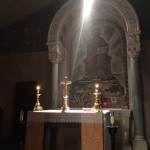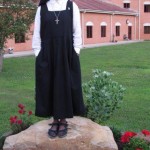Got an email from someone today wondering why I did not write about Candlemas.
Feb 2 is actually one of my very favorite feast days, the Feast of the Presentation of the Lord, (if I’d ever become a nun I’d have been Sr. Mary Whatever of the Presentation of the Christ) and I would write something about it, but Kansas Catholic has such beautiful pictures, and this priest has the info, so I’ll just send you over there.
Meanwhile, some young women are advancing in their spiritual journeys within the vowed and consecrated life. Our galpals at Summit, NJ – Monastery of Our Lady of the Rosary – who were recently featured in this photo essay, celebrated as one of its novices, Sr. Diana Marie of the Most Blessed Sacrament, made her first vows, and they’ve got video. Looks like they made a very pretty cake for her, too!
Over at Our Lady of the Angels Monastery in Hanceville, Alabama, the full-to-capacity community celebrated as three postulants were clothed Since early December. Click Photo Gallery, then click the drop window to “2009 Investments” and then “2008 Investments” to see the newly robed and shorn sisters (a tradition begun when St. Francis of Assisi cut the hair of St. Clare as she left her riches behind) and their lovely new names.
Before you ask: Why the new names? Why the “titles”? The act of changing ones name when entering into an intimacy with the Lord goes back to our earliest scriptures. Noe became Noah. Abram became Abraham. Jacob became Israel, Simon became Peter, Saul became Paul. The change bespeaks the radical departure from the former self, and one’s being “recreated in Christ.” And the “title,” the association that a nun will make, (i.e., “Sr. Katharine Mary of the Divine Mercy”, or “Therese of the Holy Face” or Teresa of Jesus, or “Elizabeth of the Trinity” is simply a declaration by this woman of the inmost mystery which compels her love and devotion. It is extraordinarily revealing and also her own hiding place, her “personal enclosure” if you will, the deep calling unto deep.
Interestingly, the Hanceville monastery is in the process of establishing two foundations, one already up and building – in Arizona – and the other just starting out in Texas. They also have sent nuns to “rescue” a monastery in Ohio that was fading out, but is now attracting new, young vocations. If they had not branched out there would be no room for the 8 or 9 young women who entered Hanceville over the past year. Our Lady of Solitude Monastery (AZ) and St. Joseph’s Monastery (OH) each welcomed a postulant within the past year.
Capuchin Sisters of Nazareth: Last year they had four postulants, this year four novices.
Poor Clares of Santa Barbara: A new postulant.
Franciscan Sisters of the Eucharist: A new novice.
Quite different from living a vowed life in community – and a more ancient way – some women feel called to become Consecrated Virgins. Wildly misunderstood in our liberated day, the early Consecrated Virgins were not the shrinking violets some imagine; for their time they were distinctly radical. In an age where women were considered little more than chattel, to be bartered in marriage for land or even sold into service, the earliest Consecrated Virgins declared themselves free in Christ, claimed by Him, for Him and set apart to live in service to Him. The rite fell by the wayside in the middle ages, but was restored by Pope Paul VI, and since then, the numbers of women setting themselves apart in this way is increasing – there are now over 3,000 Consecrated Virgins, worldwide.
Because our society has come to misunderstand and devalue virginity in such an extreme way, these modern-day Virgins may certainly be considered every bit as radical and strong as the first were.
“When I first was consecrated in 1993, I wished we had a different name for this,” said Judith Stegman, 51, association president and a certified public accountant in East Lansing, Mich. “I thought, ‘I don’t really want to live my life saying, “Are you married? No, I’m a consecrated virgin.” ‘ But a retreat master said, ‘The last thing you’d want to do is to lose that word virgin, because it’s so countercultural. It’s the only thing that really speaks to what you are and what you are doing that is so different.’ “
This infantile headline is a perfect illustration of how one’s sex life has become the full measure of womenhood. The secular world, sex-saturated and benumbed from the noise of pop-culture, cannot wrap its head around the idea; it is foolishness and weirdness and really quite “suspect” to most of the world, but these women have simply come to an understanding of who they are, and what they were born for. That’s the thing we’re all supposed to be working out, isn’t it? The purpose for which we were loved into being?
This young blogger, who was Consecrated in January of this year, writes about her ceremony here. And explains the vocation more fully here, here and here.
There is power in virginity, and in celibacy, but our society jeers at it and encourages our young people to throw that power away, before they ever get a sense of it. They particularly mock Christian celibacy, and that has always amused me. The same people who find Buddhist nuns and monks to be so much more “enlightened” than vowed Westerners do not seem to realize that the Eastern religious are also celibate, disciplined and self-contained. They too, understand the power of chastity (as do the Taoists who – for very different, energetic reasons – urge chastity as much as possible). To really examine the issue of virginity is to recognise that we are not supposed to be throwing each other away like used kleenex – but people confuse the freedom to do so with self-empowerment. Really, it is something quite different, and quite imprisoning, truth be told. Instead of mastering the body, the body masters you. And yes, the spirit is involved with all of that.
There is still time to guess the ugly churches
Related:
Pope Benedict XVI Speaks to Consecrated Virgins.











